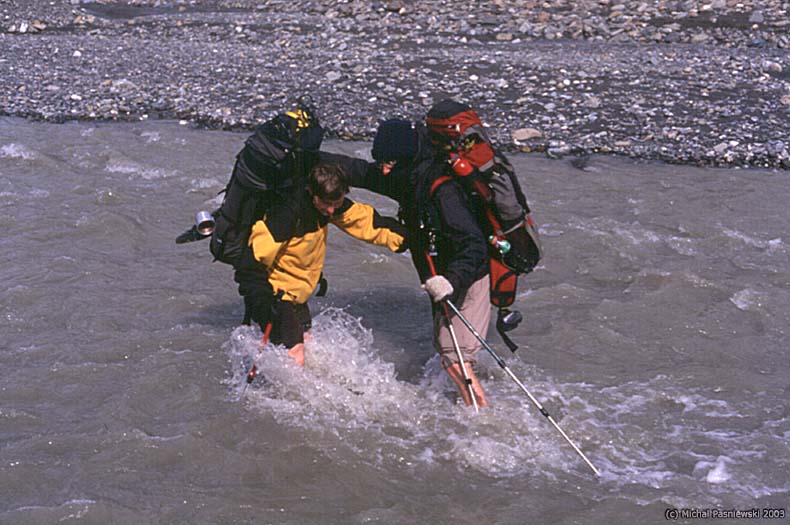Gris
New member
OK, since i have now twice been "swept off my feet" literally, once in Patagonia and more recently in the Whites, I must be doing something wrong. Is there a proper RIVER (not stream) crossing technique and if so what is it? THANKS! 



For larger streams it is ALWAYS preferable to cross with your body sideways to the current. It presents the hydraulic pressure of the water less of your body to push against and you use your downstream leg to brace yourself. I always look at the runout as well. If you get swept off your feet, where will the current take you? Have you loosened your pack straps and waist belt?
We must have crossed a hundred such streams in the Yukon (actually ribbons of a single, much larger river), though nothing quite that deep (boot to mid-calf high). facing sideways worked, as did poles and at times joining hands.Dr. Dasypodidae said:I agree with Peakbagr that one should ALWAYS cross raging streams and rivers with your body SIDEWAYS to the flow. I have crossed wide and waste-deep glacier meltwater streams on Baffin Island using this technique, where if I had not been weighted down with a heavy pack I probably would have been too light to keep my feet planted on the stream bottom.
We sometimes heard and saw large boulders making that sound, and figured that anything that swift would have done us in for sure, so we looked elsewhere.Dr. Dasypodidae said:For these kinds of crossings I strip down to skivies, wear a pair of old beat-up rag socks inside an old pair of running shoes to protect my feet from the cold and tumbling bedload, and carry the boots tied together around my neck (if you can hear the rocks in the bedload banging against one another, you might consider wearing your boots for protection).
Take heart in knowing that it was a tough crossing on Saturday after a long day.
If you can hear the rocks banging against each other, you might consider crossing elsewhere. If a rock shifts into you, you can be trapped or crushed.Dr. Dasypodidae said:if you can hear the rocks in the bedload banging against one another, you might consider wearing your boots for protection.
Peakbagr said:As a wading fisherman and hiker here are some ideas.
For small, slow moving streams where you don't want to take the socks and boots on and off, use 2 plastic garbage bags with the yellow straps. Use the straps to hold them up and shuffle across with no wasted boot changing time.
For larger streams it is ALWAYS preferable to cross with your body sideways to the current. It presents the hydraulic pressure of the water less of your body to push against and you use your downstream leg to brace yourself. I always look at the runout as well. If you get swept off your feet, where will the current take you? Have you loosened your pack straps and waist belt?
You can always use a hiking stick to help brace you and feel ahead for slippery rocks and holes in the stream bottom.

Enter your email address to join: